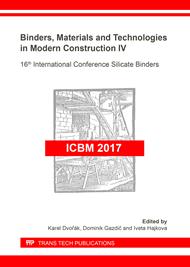p.128
p.134
p.140
p.148
p.154
p.160
p.167
p.173
p.179
Physical Properties of Selected Silicates for a Long-Term Heat Container
Abstract:
Implementation of high temperature solar reservoirs is associated with problems related to the physical properties of materials, especially with temperature resistance of the material at temperature changes, with high heat capacity, with high thermal conductivity and with material fire resistance. In the case of silicate materials, more specific materials with favourable physical properties are available, which can be used for the construction of high temperature containers. The basic prerequisite for designing such container is the knowledge of the physical properties of the heat storage core and the thermal insulation ability of container cladding layers.The paper deals with the problem of identification of material properties of silicates in the wide temperature range up to 800 °C, using the standard measurement methodology, improved by additional temperature recording at a defined distance from the thermal source during the dynamic thermal development of the linear thermal source, well-known as the hot wire method.
Info:
Periodical:
Pages:
154-159
Citation:
Online since:
June 2018
Authors:
Price:
Сopyright:
© 2018 Trans Tech Publications Ltd. All Rights Reserved
Share:
Citation:


